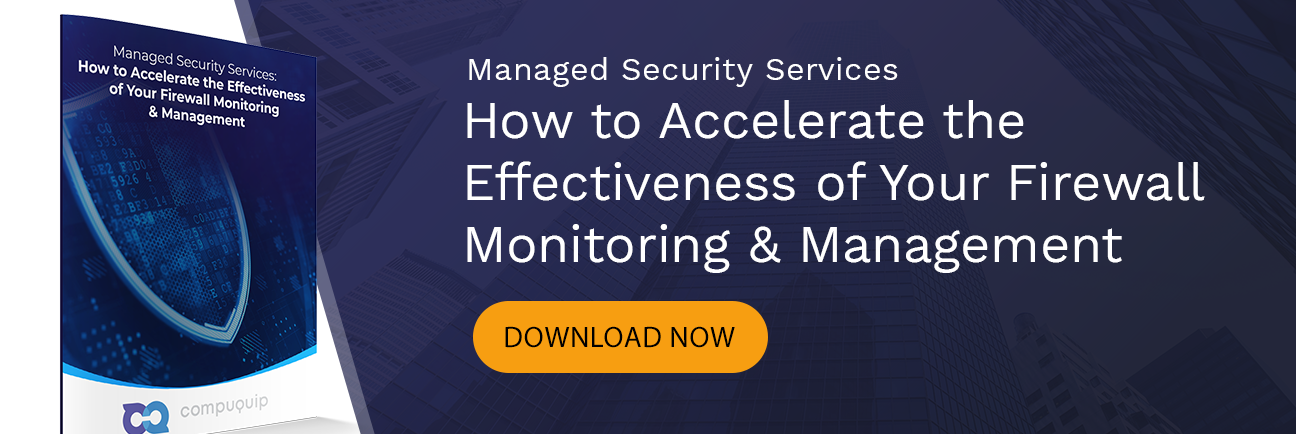The Challenges of Firewall Management for Strong Security
Firewalls, sometimes called network security devices, are a core component of any enterprise’s cybersecurity strategy. A strong set of perimeter and internal firewalls on a network can help keep malicious traffic out and slow down the breakout speed of attacks originating from within the network. However, to get the best results from a firewall deployment, that firewall needs to be managed effectively.
What are some of the biggest challenges of effective firewall management for strong security? Furthermore, how can you overcome these challenges so you can improve your network security?
Here’s a brief list of some of the biggest challenges, and some firewall management procedures/advice you can enact to overcome them:
Firewall Management Challenge #1: Choosing the Right Firewalls for Your Needs
It may surprise you to learn that there are many types of firewall architectures to choose from. Many of these architectures are the result of building upon earlier types of firewalls to improve the security they provide. The basic progression of firewalls in order of complexity and security goes something like this:
- Packet-Filtering Firewalls. These are the oldest and most basic types of firewall. They make a shallow check of data packet information such as destination and origination addresses, packet type, and port number without opening the packet for closer inspection.
- Circuit-Level Gateways. These simplistic firewall types are meant to provide fast, low-impact verification of data packets. These firewalls check the transmission control protocol (TCP) handshake to verify that the session is legitimate. It is important to note that they do not check the packet at all, so malware with a legitimate TCP handshake can easily get by.
- Stateful Inspection Firewalls. These firewalls work as a combination of both packet filtering and circuit-level gateway technology. They provide better protection than either of the previous two firewalls alone.
- Application-Level Gateways. Also known as “proxy firewalls,” these firewalls prevent the data packet from interacting directly with the network. Instead, these firewalls inspect the packet at the application layer before interacting with the network. They include the same protections as a stateful inspection firewall but may also add deep packet inspection to look at the contents of a data packet—potentially identifying malware code that other firewalls might miss.
- Next-Gen Firewalls. The most nebulous of firewall types, as there is no real consensus on what makes a firewall truly “next-gen” compared to others. These firewalls can, depending on the developer, have some or all of the capabilities the other types in this list have, or may even incorporate other technologies such as intrusion prevention systems (IPSs) to automatically work to stop an ongoing attack. As such, it is important to verify the specific features of any “next-gen” firewall before acquiring it.
As for the question of which one of these firewalls you should choose for your organization, here’s the real question: “Why only choose one firewall type?” Many organizations use different firewalls and firewall management procedures for different parts of their network to create strong network segmentation and security.
Also, the choice of firewall that you use may also depend on your organization’s specific goals. A network security device and firewall management procedure that works for one organization might not work so well for yours. So, be sure to consult with a firewall management expert before settling on any one technology.
Firewall Management Challenge #2: Creating Strong Network Segmentation
Network segmentation is a key strategy for establishing defense-in-depth against attackers. The key benefits of using strong network segmentation are that it can:
- Slow down attackers;
- Improve overall data security;
- Make implementing a policy of least privilege (POLP) easier; and
- Reduce the damage caused by a breach.
Configuring firewall deployments to create strong network segmentation is a crucial strategy for enterprises because of these benefits. The longer it takes attackers to break out from one system to another, the more time your cybersecurity experts have to identify and contain the breach. It also means reducing the total amount of data and assets that attackers can access at once—limiting damage.
One firewall management strategy to create strong network segmentation is to use a variety of firewall types to separate different parts of the network from one another. This makes it harder for attackers to use the same tactics to breach each piece of segmentation—causing further delays.
Firewall Management Challenge #3: Blocking Hostile Traffic Without Impacting Legitimate Requests
While firewalls need to block potentially hostile traffic, they also need to avoid impeding legitimate traffic requests. Otherwise, the network’s user experience will suffer—creating inconveniences and reducing productivity.
To counter this, it’s often necessary to create customized configurations for firewall settings to let through specific traffic types while blocking others. Here, having a managed firewall service can help provide the expertise needed to configure the firewall for maximum security and minimum interference.
Firewall Management Challenge #4: Managing Firewall Program Updates
Many firewall solutions are software-based and will, thus, need periodic updates to their software to close potential vulnerabilities and to update their definitions of hostile traffic. Keeping a firewall up to date is one of the most basic firewall management procedures that enterprises need to engage in, but such software updates are still easily missed when overworked IT departments have other priorities.
Using a managed firewall service can help to ensure that these critical updates are carried out immediately—which minimizes risk.
Want to know more about how you can improve your firewall management to increase cybersecurity? Download our guide on how to accelerate the effectiveness of your firewalls at the link below.

